
The question of how the Universe began and how it’s going to end has puzzled mankind for millennia. The ancient Greeks and many other civilisations believed that our Universe is eternal. Aristotle was one of the first people to think differently and he suggested that the Universe was confined in what he called a “heavenly sphere”. To everybody's surprise, around 1930 it was discovered that the Universe is not infinitely old but has a finite age. The astronomer Edward Hubble made the amazing observation that all galaxies move away from each other. Therefore, one must assume that they had been closer together 1000 years ago than they are today, still closer 1 million years ago and so on. Finally, at some time in the past, circa 13.7 billion years ago, all matter in the Universe must have been compressed at an enormously large density and temperature.
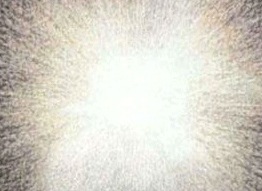
The Big Bang. Image source: Counterbalance Foundation
Since the expansion from this initial state proceeds like a gigantic explosion, this theory quickly became known as the Big Bang. Originally, the name Big Bang was used ironically and coined by opponents of the Big Bang theory, because in the 1930’s it seemed inconceivable to many people that the universe is not infinitely old. However, the name Big Bang is used ever since because it appealed to the imaginations of scientists and laypersons alike.At the moment, the Big Bang theory is the most accepted theory of the origin of the Universe - but it is far from complete. The Big Bang theory explains how the Universe may have evolved after its creation but there are many more cosmological questions. How did the Big Bang happen? And if our Universe is expanding, what is it expanding into? Some of these questions are exciting new challenges for astronomers, while others are just bewildering. For example, we know what happened to the Universe from a fraction of a second after the Big Bang, but can’t fully explain the first fraction of a second, where space and time were created. So if you asked what was before the Big Bang? Well nothing, because space and time did not exist until the Big Bang, so there is no before the Big Bang and there was no place for anything to be anyway.
The Big Bang theory states that all matter existed right from the start but it was just all in one place. Before the Big Bang, there was no time and no space. Hubble discovered that the galaxies were moving away from each other, which led to the idea of expanding space. This means that it is not the motion of the galaxies themselves that drives them away from each other. It is space itself that is moving the galaxies apart.

It may be easier to think of a rubber balloon. The balloon represents space (2-dimensional in this case). On the balloon you place hundreds of markers to represent galaxies. If you blow up the balloon, the markers appear to move away from each other but in reality, the balloon skin between each marker has stretched and moved all the 'galaxies' further apart.
Edward Hubble realised that all the galaxies were moving away from each other by observing light from extremely distant sources. He found that this light had shifted towards the red end of the visible spectrum. This can be explained by the Doppler Effect, which states that the light emitted by a source moving away from the observer is observed with a lower frequency.

Illustration of the Doppler effect. Image source: epicphysics.com
The Doppler Effect applies to all types of waves but it’s easiest to explain using sound. Imagine a motorcycle moving towards an observer B. Its engine is emitting sound waves (noise) in all directions but, as the motorcycle travels forward, it’s catching up with the sound waves it released earlier, meaning that the gap between each successive wave front gets smaller. This increases the frequency of the sound waves which means B hears a higher pitched noise. Behind the motorbike, the effect is inverse, with the spacing between wave fronts getting bigger as the motorcycle moves away from observer A, who hears a lower pitched noise.
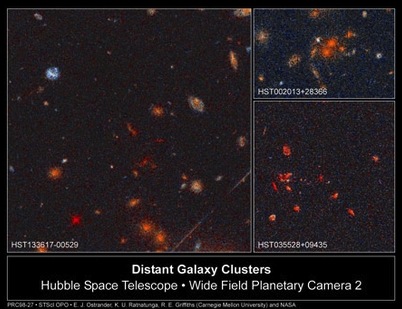
This image shows that the light of far-away galaxies is red instead of yellow because they are moving away from us. Source: ESA/NASA
Theories of what the very early Universe was like are highly speculative as it is very difficult to know in detail about things that happened 13.7 billion years ago.
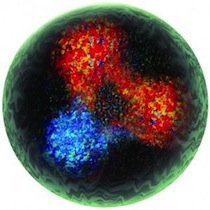
About a millisecond after the Big Bang, temperatures had cooled down enough to allow protons and neutrons to form through the merging of three elementary quarks.
There are six different kinds of quarks. Two of them build up almost all matter: the up and down quark. Three quarks can join to either form a proton (2 up + 1 down) or a neutron (1 up + 2 down).
In 1965 two American scientists, Penzias and Wilson, built a new radio antenna, of unprecedented sensitivity, in order to measure satellite signals. They accidentally discovered a mysterious microwave radiation coming from far out in space, but had no idea about its origin. It was later found out that this radiation was created in the Big Bang. It is called cosmic microwave background radiation and it raises the temperature of space from zero up to 2.7K. The radiation is almost perfectly uniform in all directions.

You can even observe the background radiation yourself! Anyone who has have seen an analogue TV before it has been properly set-up knows it will show 'static' on the screen. About 10% of the flickering one sees is due to the background radiation. Of course this won’t happen in the case of digital TVs.
Where does it come from?
After the creation of the first atomic nuclei of hydrogen, helium, and of traces of lithium, these light elements remained embedded in a sea of electrons which originated from even earlier moments in the history of the Universe. Each electron carries a negative electric charge whereas each proton is positively charged. These protons and electrons are attracted to each other due to their opposite charges and so the electrons try to form clouds around the protons.
However, the high temperature immediately dissolves the clouds and sends protons and electrons through space on random paths. It took 300 000 years for the Universe to expand and cool down enough to reach a temperature at which an electron cloud would remain stable. Nuclei with accompanying electrons are what we know now as atoms.
The paths of photons (light particles) can be changed by collisions with electric charges but they do not interact with neutral atoms. Therefore, the original Big Bang photons continued unperturbed on their paths once all electrons had been incorporated in atoms, and we see those photons today as the cosmic background radiation. Thus, this radiation gives a snapshot of the Universe at an "infant" age of 300 000 years.
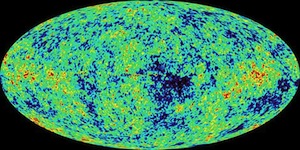
The figure shows a detailed, all-sky picture of the infant universe created from nine years of WMAP data. The different colours in this picture show that the Universe 300 000 years after the Big Bang was not the same everywhere. The colour differences indicate temperature fluctuations that correspond to the seeds that grew to become the galaxies. Source: NASA/WMAP
Is there any proof of the Big Bang Theory ? Indeed, this theory is supported by the following observations:
For about one billion years after the Big Bang, the Universe consisted only of hydrogen and helium in gaseous form. There were no stars and no planets. Eventually, some the gas clouds began to collapse in on themselves to form protostars which eventually became hot enough to ignite, creating the very first stars. From stars, galaxies and planets then form. However, our Sun didn’t form until generations of stars had been and gone, 8 to 9 billion years after the Big Bang.
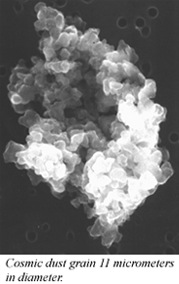
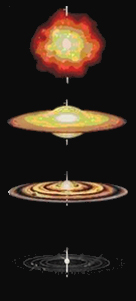
The surrounding dust and gas slowly merged together under the effect of gravitation, as larger pieces attracted smaller pieces. As they grew, their weight eventually made them spherical and they became planets.
We are fortunate that our Solar System formed quite late. Our planet is made out of rock which did not exist in earlier times in the Universe. These heavy elements had to be made by other stars and then cast out back into space when the stars died. This matter then collected around our Sun and formed not just the Earth, but Mercury, Venus and Mars as well.
The solar system consisting of the Sun and the planets was formed from a cloud of gas and dust looking something like this. Source: NASAEven if one can measure how quickly the galaxies are moving away from each other, it is not easy to predict what will happen in the future of the Universe. The expansion of the Universe is primarily powered by the Big Bang but the matter in the Universe can gravitationally pull everything back towards the centre.
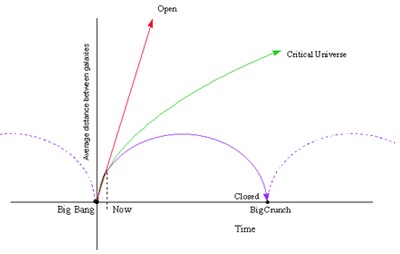
The Earth is about 4600 million years old. In the beginning, Earth was so hot that everything was molten. After 500 million years Earth had cooled down enough so that oceans could form and the planet became habitable. Then the first primitive forms of life appeared in the oceans. It then took an enormously long time (about 4 000 million years) for life to develop from the first primitive life forms to plants, then to animals, and finally to human beings.
Human beings have lived on Earth only for the last 4 million years. And only for less than 100 years mankind has an understanding of how the Universe is structured up and how it came into existence in the Big Bang.

The conditions on Earth were just right for life. It is just the right temperature for liquid water, close enough to the Sun to use its energy, oxygen for us to breathe and a moon to stabilise our climate.
This illustration represents the natural phenomena which have created life as we know it on Earth. Source: California Space InstituteMany scientists think that there is life outside Earth. With billions of other star systems, it seems absurd to believe that Earth is the only planet capable of harbouring life. In our solar system the most probable locations where primitive life could exist are Mars and one of Jupiter’s moons. On Mars, there is evidence that water was there in the past, and scientists think that on Europa, a gigantic ocean lies below the icy surface.
As of 2011, well over 500 planets outside the Solar system have been discovered and more planets are being found all the time. On some of those, there could be just the right conditions for life. Perhaps there could be technical civilisations that are much further advanced than we are. However, some people feel that if there were so many aliens out there, we would have seen some by now. This is called Fermi’s paradox, because it was Enrico Fermi who first formulated this idea. One of the most plausible explanations for this is that the huge distances between different advanced civilisations do not allow contact. Even if there were 1000 advanced civilisations out there, if we are all 1000 light-years apart it is unlikely that someone will be coming to Earth for a visit.

Some scientists feel that it’s incredibly lucky that out of all the infinite possibilities of how our Universe could have evolved, it just so happens, that it has evolved to create just the right conditions for us to survive. For example, at the time of the Big Bang there was only a tiny surplus (one billionth) of matter with respect to antimatter in the Universe. If the amounts had been exactly the same, all matter and antimatter would have been annihilated and transformed into radiation, leading to a boring Universe without anything solid, including ourselves. If the surplus of matter had been only a very tiny amount larger or smaller than the actual value, no life would have been possible. If it had been a little larger, the Universe would have collapsed due to gravitational attraction. There simply would not have been enough time to develop life. On the other hand, if the surplus of matter had only been a little smaller the expansion would have been so fast that no bound structures could have formed and the Universe would contain only elementary particles.
